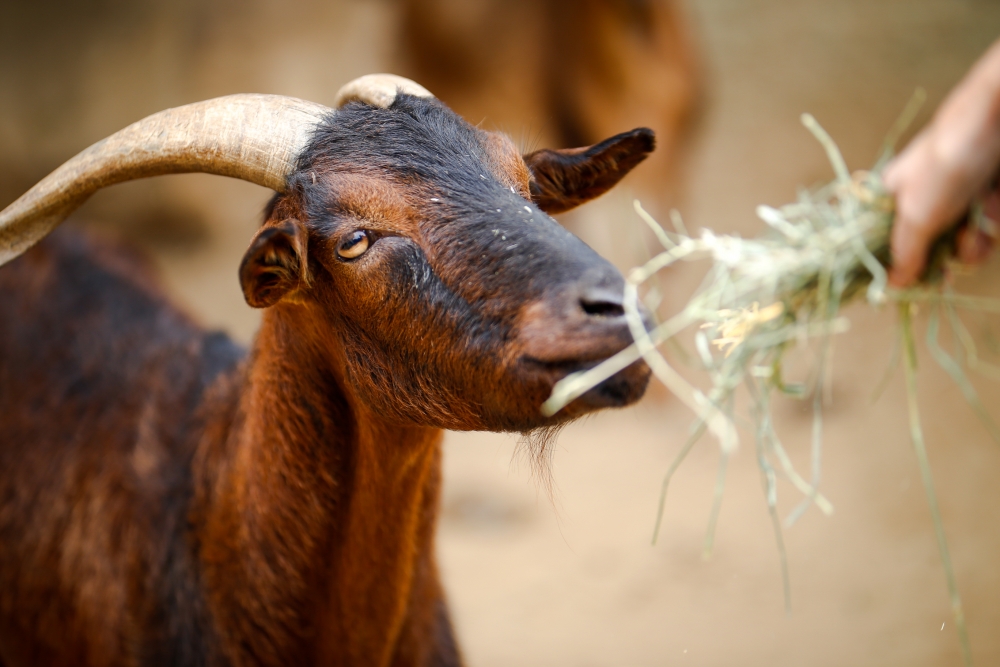
Wonder Fungi

Michelle O’Malley has long been inspired by gut microbes. Since she began studying the herbivore digestive tract, the UC Santa Barbara chemical engineering professor has guided several students to their doctoral degrees, won early and mid-career awards (including a recognition from President Obama), attained tenure and advanced to the position of full professor. A constant through it all: goat poop.
“This has been the longest single effort in my lab,” said O’Malley, who with her research team way back in 2015 first embarked on an ambitious project to characterize gut microbes in large herbivores. The purpose? To understand how these animals manage, via their microbiomes, to extract energy from plant material, particularly the fibrous, non-food parts, where sugars are locked behind tough plant cell walls. Understanding this process could reveal methods for extracting the raw materials necessary for a wide variety of the chemicals required for modern life — from biofuels to pharmaceuticals — all from abundant, renewable, plant parts. This, in turn, could decrease or even eliminate our reliance on more finite resources for these materials.
Now, O’Malley has reached another milestone. In a paper in the journal Nature Microbiology, she and her team report the results of more than 400 parallel anaerobic enrichment experiments, which include more than 700 previously unknown microbial genomes and thousands of new enzymes, as well as a possible mechanism for much of the methane often blamed on cows and goats.
Microbial Roll Call
“One of the things we wanted to do with this study was to ask ourselves if we could learn the bioprocessing lessons that the goat digestive tract has to offer,” O’Malley said. Like all ruminants, goats have gut microbiomes that have evolved over millions of years to secrete powerful enzymes that break down tough plant parts, allowing the animals access to nutrition from a variety of vegetation.
“The aim of the study is really to learn about the microbes, and, importantly, the teams of microbes that do those difficult jobs,” she said.
Of particular interest to the researchers were the non-bacteria denizens of the goat gut microbiome — “minor players” like anaerobic fungi that constitute a tiny fraction of the bacteria-dominated population. Not only are these members of the community few and far between, they are difficult to culture, O’Malley said. So while gut microbiome research has been going on for a long time, most studies ignore the contributions of rare members of the microbiome.
“Nobody had really looked at the effects of these rare members,” she said.
Over roughly 400 parallel enrichment experiments on fecal matter contributed by Elway, a San Clemente Island Goat named who lives at the Santa Barbara Zoo, the researchers teased out populations of biomass-degrading microbes with different biomass substrates. They further sculpted some of these populations using antibiotics to inhibit the growth of bacteria, leaving rarer microbes such as fungi and methanogens (single-celled organisms from the domain Archaea) to dominate.
“And then we sequenced all of those cultures,” O’Malley said. “We put the fragmented DNA sequences back together again to reconstruct high-quality genomes, and that gave us a collective picture of who was there. Then we scanned these genomes for enzymes and pathways that gave us a clue as to what each microbe was doing in the microbiome.” The O’Malley lab researchers sequenced these samples at the Department of Energy Joint Genome Institute (JGI) as part of the JGI Community Science Program; they collaborated with JGI experts in metagenome sequencing and fungal genomics for this study.
In the process, the team uncovered more than 700 novel microbial genomes “unique at the species level,” according to the study. Also present were rare fungi they had previously isolated from large herbivores.
“But this was the first time we had really seen them in action, in their normal community,” O’Malley said.
Heavy Hitters
For their small population, fungi, it turns out, play a disproportionately large role in biomass degradation.
“They produce the lion’s share of the biomass degrading enzymes that the community relies on to function,” O’Malley noted. Additionally, according to the paper, fungi have other strategies, such the ability to physically penetrate plant cell walls, exposing surfaces for these enzymes to act on.
The researchers also found that along with the increased rate of biomass degradation came an increase in methane production in the fungal-dominated consortia. While both gut bacteria and gut fungi form cross-domain partnerships with methanogens, essentially passing carbon to the archaeans that ferment it into natural gas, fungi seem to be more efficient at it.
“We think the fungi are more effective at shunting carbon to methane,” O’Malley said. “In other words, fungi are not producing a bunch of side products like bacteria would. Bacteria produce additional short-chain fatty acids and other chemical products, in addition to some methane. But, the fungi may have a more direct route passing materials to the methanogens.” This, according to the paper, suggests that “fungi play a larger role in methane release than previously recognized.”
These and other insights from the research take us closer to developing technologies using microbes to create industrially important chemicals from cellulose, the most abundant organic compound on the planet. O’Malley and her group are focused on understanding the roles of and interactions between members of these complex ruminal communities, and they’re looking to a future where designed microbial communities can create value-added chemicals.
“Can we build a bio-reactor that houses not just one type of microbe, but a few, or dozens? Can we do really complex chemistry the way nature does? That’s kind of the ultimate goal here,” O’Malley said.
Research in this paper was conducted also by Xuefeng “Nick” Peng, St. Elmo Wilken, Thomas S. Lankiewicz, Sean P. Gilmore, Jennifer L. Brown, Joh K. Henske, Candice L. Swift and David L. Valentine of UC Santa Barbara; Asaf Salamov, Kerrie Barry and Igor V. Grigoriev of the Department of Energy Joint Genome Institute at Lawrence Berkeley National Laboratory; and Michael K. Theodorou of Harper Adams University in the U.K. The research was funded by grants from the National Science Foundation, the Department of Energy through the Joint BioEnergy Institute (JBEI) at Lawrence Berkeley National Laboratory, the Institute for Collaborative Biotechnologies (ICB), and a New Partnership grant from the California NanoSystems Institute (CNSI) on the UC Santa Barbara campus.



